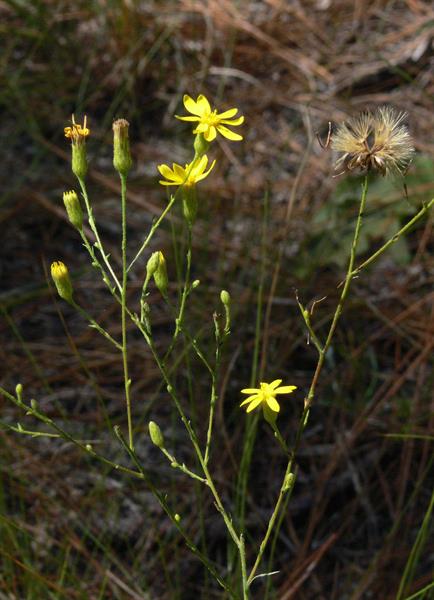
Origin/Endemic status: Endemic
Taxonomy Comments: P. aspera var. adenolepis includes 2 chromosome numbers (2n = 18 and 36), which "account, in part, for the range of variation in involucre, floret, and fruit size" (Semple & Bowers 1985). Nesom (2019a) subsumes this variety under a more broadly defined P. aspera, since he did not find a clear morphological or geographic separation between these varieties. We are tentatively maintaining the varieties, pending further field study of this variation.
Synonymy: = FNA20, K1, K3, Va, Semple & Bowers (1985); = Chrysopsis graminifolia (Michx.) Elliott – F, misapplied; = Heterotheca adenolepis (Fernald) H.E.Ahles – Bowers (1972); = n/a – Tat; = Pityopsis adenolepis (Fernald) Semple; < Chrysopsis graminifolia (Michx.) Elliott var. aspera (Shuttlew. ex Small) A.Gray – C, G, SE1, W; > Heterotheca adenolepis (Fernald) H.E.Ahles – RAB; < Heterotheca aspera (Shuttlew. ex Small) Shinners; > Heterotheca graminifolia (Michx.) Shinners – RAB, misapplied; < Pityopsis aspera (Shuttlew. ex Small) Small – Fl7, K4, S, WH3, Nesom (2019a)
Heliophily: 8
Hover over a shape, letter, icon, or arrow on the map for definition or see the legend.
 © Gary P. Fleming | Original Image ⭷
© Gary P. Fleming | Original Image ⭷ © Bruce A. Sorrie | Original Image ⭷
© Bruce A. Sorrie | Original Image ⭷ © Scott Ward | Original Image ⭷
© Scott Ward | Original Image ⭷ © Scott Ward | Original Image ⭷
© Scott Ward | Original Image ⭷ © Alan Weakley source | Original Image ⭷
© Alan Weakley source | Original Image ⭷ © Bruce A. Sorrie | Original Image ⭷
© Bruce A. Sorrie | Original Image ⭷ © Bruce A. Sorrie | Original Image ⭷
© Bruce A. Sorrie | Original Image ⭷ © Gary P. Fleming | Original Image ⭷
© Gary P. Fleming | Original Image ⭷ © Alan M. Cressler | Original Image ⭷
© Alan M. Cressler | Original Image ⭷ © Alan Weakley source | Original Image ⭷
© Alan Weakley source | Original Image ⭷ © Alan Weakley source | Original Image ⭷
© Alan Weakley source | Original Image ⭷Feedback
See something wrong or missing on about Pityopsis aspera var. adenolepis? Let us know here: (Please include your name and email if at all complicated so we can clarify if needed.)
Cite as...